Georgina (Dahlia) – planting, care and storage
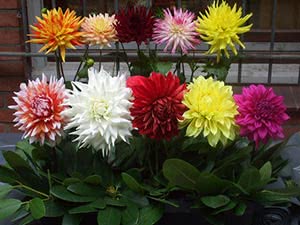 Dahlia flowers (lat. Georgina) are one of the most beautiful and long-flowering garden flowers in the family Asteraceae having a broad range of flower colors and a variety of shapes. In addition to its beauty one of the most important qualities of dahlia is that they bloom from July till the frosts.
Dahlia flowers (lat. Georgina) are one of the most beautiful and long-flowering garden flowers in the family Asteraceae having a broad range of flower colors and a variety of shapes. In addition to its beauty one of the most important qualities of dahlia is that they bloom from July till the frosts.
The first tubers of dahlia were brought to Europe from Mexico at the end of the 18th century. In 1803 the plant received its name from the botanist Carl Willdenow, who named the dahlia plant in honor of a famous botanist, ethnographer and geographer from Petersburg, academician Johann Georgi. There are about thirty species and 15,000 varieties of dahlia.
Growing of dahlia: peculiarities
The shape, bloom colors and varieties of dahlia are so diverse that they can be used to decorate not only flower beds, but also edge line. Dahlia can be grown both as a single plant and as a potted flower. Dahlias are dazzlingly beautiful, but at the same time it is very easy to care for it. The main requirements for their successful growth and lush flowering are to choose the right planting place, to use a proper substrate, to water and fertilize them timely. It is necessary to buy seedlings not earlier than in the middle of spring, and the tubers should be fleshy and strong, with already noticeable, but not high sprouts. It is better not to take a soft or dry tuber.
Varieties of dahlia
Dahlias are classified by the shape and structure of their inflorescences. Currently there are 12 main classes of dahlia, but as new varieties are created, new classes appear. So, the most popular varieties of dahlia are:
- single-flowered dahlia has one row of florets, reaching 4 inches in diameter and from 17.7 to 24 inches in height. Single-flowered dahlias include such varieties as Yellow Hammer of a yellow color, Princess Marie Jose of a pink color, and Orangeade of a red-orange color;
-
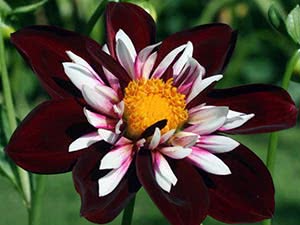 anemone-flowered dahlia has one or more outer rings of ray florets with elongated disc florets at the center. Inflorescences reach 4 inches in a diameter, the height is from 24 to 35 inches. The most popular varieties are Vera Higgins of a bronze color, yellow-lilac Lucy, red Comet;
anemone-flowered dahlia has one or more outer rings of ray florets with elongated disc florets at the center. Inflorescences reach 4 inches in a diameter, the height is from 24 to 35 inches. The most popular varieties are Vera Higgins of a bronze color, yellow-lilac Lucy, red Comet; -
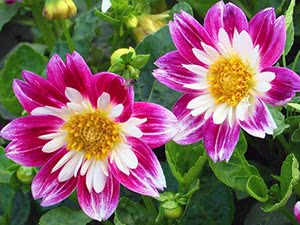 collarette dahlias are of the same size, but higher – from 29.5 to 47 inches. They have one outer ring of ray florets that is overlapped with a ring of shorter and twisted petals of a different color, looking like a collar. The varieties are Chimborazo (red with cream), La Gioconda (scarlet with gold), Claire de Luna (yellow with cream);
collarette dahlias are of the same size, but higher – from 29.5 to 47 inches. They have one outer ring of ray florets that is overlapped with a ring of shorter and twisted petals of a different color, looking like a collar. The varieties are Chimborazo (red with cream), La Gioconda (scarlet with gold), Claire de Luna (yellow with cream); -
 peony-flowered dahlias are slightly larger, from 4.7 to 6 inches, with 2 or more rows of flat ray florets surrounding disc florets at the center. They are as high as collarette dahlias. Popular varieties are Fascination of a lilac color, and Symphonia dahlia of a crimson red color;
peony-flowered dahlias are slightly larger, from 4.7 to 6 inches, with 2 or more rows of flat ray florets surrounding disc florets at the center. They are as high as collarette dahlias. Popular varieties are Fascination of a lilac color, and Symphonia dahlia of a crimson red color; -
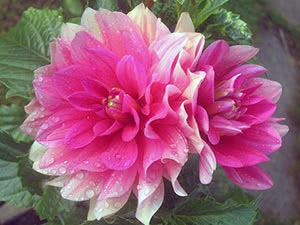 decorative dahlias include Jocondo with purple giant flowers, Thames Valley with large yellow flowers, David Howard with miniature orange inflorescences. All varieties have double inflorescences from 3 to 10 inches in diameter, the height is up to 24 inches;
decorative dahlias include Jocondo with purple giant flowers, Thames Valley with large yellow flowers, David Howard with miniature orange inflorescences. All varieties have double inflorescences from 3 to 10 inches in diameter, the height is up to 24 inches; -
 ball dahlias have double inflorescences of a globe shape. Some of them can have a slightly flattened shape. The diameter of flowers is from 3 to 6 inches and the height is from 35 to 47 inches. The varieties are Doreen Hayes of a red color, Esmonde of a yellow color and Crichton Honey of a red-peach color;
ball dahlias have double inflorescences of a globe shape. Some of them can have a slightly flattened shape. The diameter of flowers is from 3 to 6 inches and the height is from 35 to 47 inches. The varieties are Doreen Hayes of a red color, Esmonde of a yellow color and Crichton Honey of a red-peach color; -
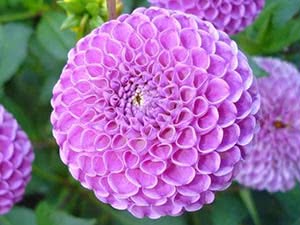 pompon dahlias have ball-shaped double inflorescences from 2 inches or more in diameter. The ray florets are curled, blunt or rounded at the tips. They reach from 35 to 47 inches in height. The varieties are Noreen with pink flowers, Hallmark of a lavender color and Willo's Violet with pale purple flowers;
pompon dahlias have ball-shaped double inflorescences from 2 inches or more in diameter. The ray florets are curled, blunt or rounded at the tips. They reach from 35 to 47 inches in height. The varieties are Noreen with pink flowers, Hallmark of a lavender color and Willo's Violet with pale purple flowers; -
 Cactus dahlias have double flowers with a diameter of 3 to 10 inches or even more, the height is 35-59 inches. The ray florets are incurving, narrow and pointed. The varieties are giant pink Danny, miniature yellow Pirouette, large red Visit, small red Doris Day;
Cactus dahlias have double flowers with a diameter of 3 to 10 inches or even more, the height is 35-59 inches. The ray florets are incurving, narrow and pointed. The varieties are giant pink Danny, miniature yellow Pirouette, large red Visit, small red Doris Day; - Semi-cactus dahlias have double inflorescences 3-10 inches in diameter, 35-59 inches in height, the ray florets are rolled half their length. The varieties are large yellow Nantenan, miniature yellow Yellow Mood, orange Autumn Fire of a medium size and white small White Swallow;
-
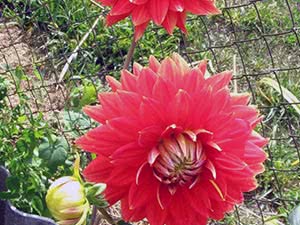 waterlily dahlias really look like waterlilies. They have double inflorescences of a beautiful, regular shape. The diameter is 2.7-7.8 inches, the height is 27-51 inches. The varieties are purple Brushstrokes, Gerrie Hoek of a gentle pink color, snow-white Jeanette;
waterlily dahlias really look like waterlilies. They have double inflorescences of a beautiful, regular shape. The diameter is 2.7-7.8 inches, the height is 27-51 inches. The varieties are purple Brushstrokes, Gerrie Hoek of a gentle pink color, snow-white Jeanette; - miscellaneous dahlias include all varieties that do not fall into any of the above mentioned groups.
In addition to the diversity of shapes, dahlias also offer a wide range of flower colors. Thus there is dahlia with black or rather red-black flowers because of accumulation of a large amount of anthocyanin pigments in the plant. But the cherished dream of all breeders is to breed blue dahlia, and although they have not succeeded yet, the hope of ever seeing this miracle is so strong that it has already received a huge feedback from writers and filmmakers.
How to grow dahlias
Growing of dahlias is related to laborious digging and responsible storage of tubers, but if you do not want to handle these problems, you can grow annual dahlias from seeds. Annual dahlias are as beautiful and simple in growing as perennials are, and the range of varieties is wide: Coltness Hybrids has the height of up to 20 inches and many simple flowers of various colors; Redskin has bronze-colored leaves; Rigoletto has small double flowers; Figaro has an early-flowering, etc. You can buy the seeds and sow them in an open ground in the middle of May, but then they will start blooming only by the middle of August. If you want to achieve earlier flowering, you will have to germinate the seeds.
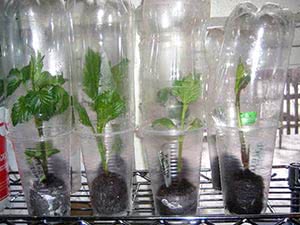 In order to do this, in the first days of April you should sow dahlia seeds in greenhouses or plastic containers, using calcined sand as soil: seeds are sown into the sand, then sprinkle sand over the seeds, well moisten and cover with transparent polyethylene. Seeds are germinated for about ten days at a temperature of 77 °-80 ° F, then the sprouts should be pricked out into individual pots. The soil mixture must have a good water capacity and be loose. It can be bought, or you can prepare it by yourself: mix one part of peat and sand and two parts of leaf soil. Three days before the picking-out, the soil must be processed with a hot solution of potassium permanganate (158 °F) of a dark pink color. After picking, the seedlings are watered as the soil dries. In the middle of May dahlia can be planted out in the ground.
In order to do this, in the first days of April you should sow dahlia seeds in greenhouses or plastic containers, using calcined sand as soil: seeds are sown into the sand, then sprinkle sand over the seeds, well moisten and cover with transparent polyethylene. Seeds are germinated for about ten days at a temperature of 77 °-80 ° F, then the sprouts should be pricked out into individual pots. The soil mixture must have a good water capacity and be loose. It can be bought, or you can prepare it by yourself: mix one part of peat and sand and two parts of leaf soil. Three days before the picking-out, the soil must be processed with a hot solution of potassium permanganate (158 °F) of a dark pink color. After picking, the seedlings are watered as the soil dries. In the middle of May dahlia can be planted out in the ground.
Planting of dahlia: preparation and process
Where to plant dahlias
Preparation starts with the choice of a planting place. Dahlia flowers cannot tolerate drafts, but requires a good airing and light, so planting of dahlia should be carried out on a sunny site, protected from the wind. The soil must be a well drained, permeable, and nutritious. Dahlias can grow on the soil with a lack or excess of acidity, but a weakly acidic or neutral soil will be optimal for them. If the soil is too acidic (pH 5-4), add slaked lime to it, if the pH is higher than 8.5, you can “acidify” the soil with peat.
In autumn, when digging over the soil, enrich the area chosen for dahlias with humus and compost (6.6-11 pounds per 35 ft3). In spring before planting scatter mature compost (not leaf mold) and a little of wood ash over the site and rake the soil. To protect dahlias from diseases and prevent their degenerating, it is advisable to change the planting place every year, letting the soil rest at least for three years. Do not plant dahlias on the sites where asters or plants with fungal diseases were predecessors.
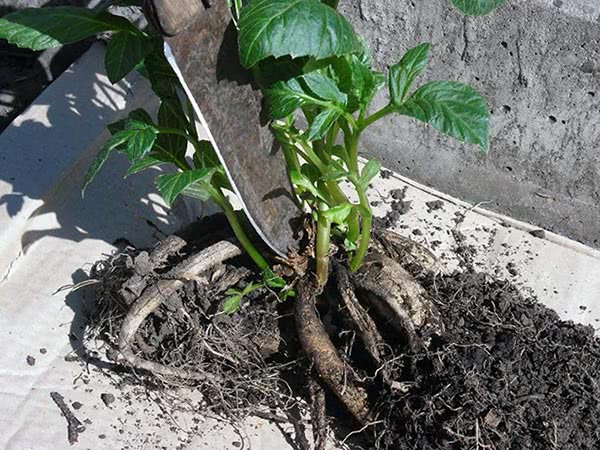
Preparing dahlia tubers for planting
In April, the roots of dahlia (tubers) should get prepared for planting: clean them from dry roots, remove damaged areas, treating all slices with an antiseptic. Then the tubers are planted in a container with nutritious soil or peat, dahlia tubers should be 0.8-1.2 inches above the surface, and keep them at a temperature of at least 64 °F and with a good light for two weeks. As soon as the buds appear, cut the tubers into pieces so that each piece will have one bud with a root neck. Sometimes one tuber produces five such parts. Divided into pieces, the tubers still need to germinate in a box for a while, and then, after removing the lateral shoots that are 4 inches long, the tubers are planted in the soil. The cut shoots can be used as cuttings: plant them in soil, keep in a dark place and water them well. The cuttings that took roots are planted out in a permanent place. Cutting and division of tubers are carried out to increase the amount of planting stock and prevent the degeneration of the plant. If it is not important for you, then there is no need to divide the tubers.
Planting dahlias in the open ground
 Planting of dahlias in the ground should happen when the soil gets warm enough. Usually it is carried out in late May or early June. Planting holes for dahlias should be three times more than a lump of roots (16x16x16), so when dahlia’s roots are completely immersed in the hole, there is still 2-2.7 inches left. At the bottom of the hole put a layer of compost or manure, then mix the manure with soil not to burn the roots of dahlia, place a germinated tuber and cover a few inches of the stem with the soil. If you plant a variety of a tall dahlia, set up and fasten the support stick for the future stem at once. After planting you should abundantly water the seedlings with cold water, and mulch the soil around them with a two-inch layer of fine wood bark or sawdust, pre-mixed with peat or compost.
Planting of dahlias in the ground should happen when the soil gets warm enough. Usually it is carried out in late May or early June. Planting holes for dahlias should be three times more than a lump of roots (16x16x16), so when dahlia’s roots are completely immersed in the hole, there is still 2-2.7 inches left. At the bottom of the hole put a layer of compost or manure, then mix the manure with soil not to burn the roots of dahlia, place a germinated tuber and cover a few inches of the stem with the soil. If you plant a variety of a tall dahlia, set up and fasten the support stick for the future stem at once. After planting you should abundantly water the seedlings with cold water, and mulch the soil around them with a two-inch layer of fine wood bark or sawdust, pre-mixed with peat or compost.
Care for dahlias
How to care for dahlias
In addition to protecting the plants from slugs, mulching will make you free from such a tedious work as weeding and loosening of the soil, and also it will not let the soil dry out quickly in hot days. Watering of dahlias should be abundant, 1-2 times a week (if there are no rains), but do not let the moisture stagnate in the roots: dahlia tubers are prone to rotting. In a very hot days, moisture is preserved by earthing up after watering. Before the next watering, you should scrape off the soil from the stems, water the plants, and then earth it up again.
Fertilizers of dahlias
As dahlia grows, it should be fed every two weeks, alternating mineral fertilizers with organic fertilizers: ammonium nitrate (0.5 oz per 11ft²), mullein 1:10 or bird droppings 1:20. When the first buds appear, you can start applying superphosphate and potassium fertilizers at a rate of 1 oz per bucket of water (enough for 8 bushes).
Support for dahlias
Since dahlia has a hollow stem and a strong wind or rain can break it, it is necessary to fix dahlia to the peg. If the stem does break, try to put a tire on it: attach a strong branch to the stem, fasten it and support the stem so that it does not tilt. Timely and attentive care for dahlias can save even a broken stem that will reward you with a beautiful flowering.
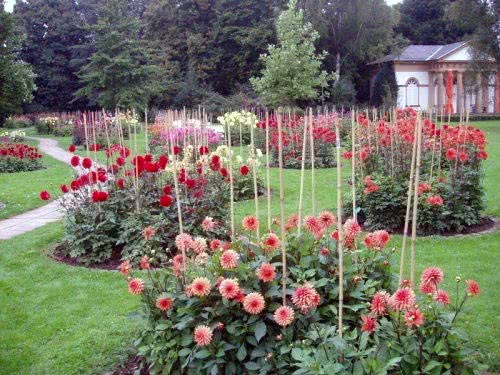
Pruning of dahlias
If it is not the quantity but the quality of inflorescences that matters, there should be no more than three shoots on the bush, otherwise the inflorescences will be smaller in size and not so beautiful. On each peduncle there should be 1-2 buds. Remove faded buds not to delay the formation and growth of new buds. Throughout the season if dahlia is tall, you should remove the lower lateral shoots that can be used as cuttings. There is no need to remove these shoots if dahlia is low (pompon, cactus) and single-flowered.
Pests of dahlias
Young succulent stems of dahlia attract slugs, and earwigs prefer buds, so when the first signs of pest aggression are noticed, treat the bushes with decoctions of wormwood or celandine about once a week in the evening. In the heat, sprinkle dahlias with systemic insecticides to control thrips, aphids, mites and caterpillars. Aphids like dahlia more than all other pests. There is a time-proven way to control them: just process plants with a soap solution.
Lifting of dahlia tubers
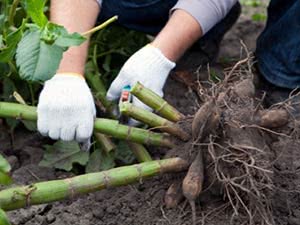 After the first frosts, dahlia tubers should be dug out, the remaining foliage and shoots should be cut off, leaving only 2-4 inch stem. Some gardeners cut off stalks and leaves a few days before lifting the tubers, but if the moisture gets to the cut part, the base of the stem can start rotting, so when cutting off the stems, immediately cover the dahlias with aluminum foil. The tuber neck is particularly fragile, so start digging the tubers in the morning in dry weather, so that they will have time to dry out and become less “brittle”. In addition, it is easier to remove the soil from dry tubers.
After the first frosts, dahlia tubers should be dug out, the remaining foliage and shoots should be cut off, leaving only 2-4 inch stem. Some gardeners cut off stalks and leaves a few days before lifting the tubers, but if the moisture gets to the cut part, the base of the stem can start rotting, so when cutting off the stems, immediately cover the dahlias with aluminum foil. The tuber neck is particularly fragile, so start digging the tubers in the morning in dry weather, so that they will have time to dry out and become less “brittle”. In addition, it is easier to remove the soil from dry tubers.
Digging out tubers of dahlias
At a distance of about 12 inches from the stem dig the plant around to cut off long vascular roots, put the forks under the soil clod and push it off the ground. Thoroughly clean the tubers from the clods of soil and turn them over for drying. When you finish lifting all tubers, wash them by the garden hose to remove the soil containing the disease-producing microorganisms. Do not delay with lifting of tubers, since after the first frosts there may be warming and the buds may wake up and begin germinating that is fatal for the plants at such a time.
Как хранить георгины зимой
A proper storage of dahlias in winter is a 90% success in their cultivation. In winter the tubers left for storage should not dry up too much, otherwise in spring they will give weak shoots. Insufficient drying leads to the root rotting during the storage. If any mechanical damages of the tuber are found, they need to be cut and then processed with charcoal. For the root neck not to rot while being stored, they are powdered with ashes or chalk.
It is the best to store the dahlia tubers at a temperature of 37 °-41 ° F with an air humidity of 60-70% in a well-ventilated room. A dry cellar will be the best place, but the vegetables if stored nearby can create a high humidity, increasing the risk of rot and fungal diseases. You can put the tubers in a box immerging them in a dry peat, you can use softwood sawdust or sand instead of peat. If the tubers suddenly begin drying up or fading, the insulating material should be slightly moistened. If there is no ventilation in the basement, you will have to turn on the fan three times a week for half an hour.
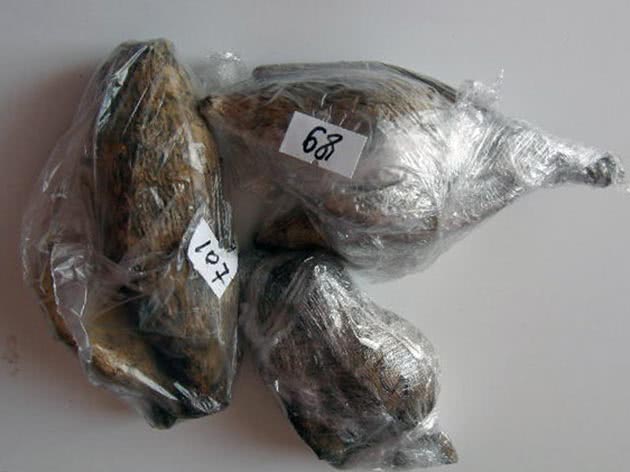
If you do not have a basement or a cellar, and you have to store dahlia tubers in the house, place the boxes with the tubers in the coolest place (next to the balcony). You can put tubers in plastic bags with insulating material (sawdust, sand, dry peat) and tie them up. Some growers wrap each tuber in a newspaper, put them in a plastic bag, and then store it in a cardboard box and put in a cool place, for example, a glassed-in loggia. Only in this case you have to keep an eye on the temperature outside for a sharp fall of temperature or frosts not to destroy your planting stock.
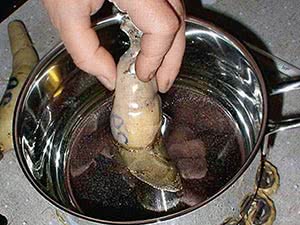 Warm and damp rooms are the least suitable for storage of the dahlia tubers, but it is still possible to store them even in such unfavourable conditions if the tubers are embedded in paraffin. In order to do this you should melt paraffin in a water bath, immerse the tuber in it for a second, let the film harden for a few seconds, and again lower the tuber into liquid paraffin. After the waxing procedure, place the tubers along with a dry peat, sand or sawdust in a plastic bag and tie it up tightly. Before planting these tubers need to be slightly rubbed for the film to crack.
Warm and damp rooms are the least suitable for storage of the dahlia tubers, but it is still possible to store them even in such unfavourable conditions if the tubers are embedded in paraffin. In order to do this you should melt paraffin in a water bath, immerse the tuber in it for a second, let the film harden for a few seconds, and again lower the tuber into liquid paraffin. After the waxing procedure, place the tubers along with a dry peat, sand or sawdust in a plastic bag and tie it up tightly. Before planting these tubers need to be slightly rubbed for the film to crack.
During winter, do not forget to inspect the tubers to be able to spot the first signs of rot in time. Affected areas need to be cleaned to get a healthy tissue and treated with an antiseptic or charcoal powder obtained from deciduous trees.
